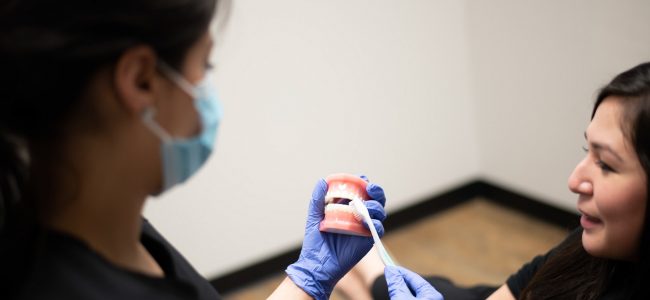We get it: you brush your teeth every day — hopefully, twice a day — so you’re probably pretty confident that you know what you’re doing. But as we’ve learned with handwashing during the pandemic, just because you’re doing it often doesn’t mean you’re doing it right. The push to teach proper hand washing has given us gems like Wash Your Lyrics, but unfortunately, we’re still waiting on the toothbrushing equivalent.
We do, however, have an easy way to remember the right way to brush: 2×2.
You should brush your teeth twice a day, for two minutes each time.
The best part? It’s way easier than you think.
First, wet your brush. Use a pea-sized amount of toothpaste on the bristles, and then place the toothbrush up to your gums at a 45-degree angle. Gently move the brush back and forth in short strokes that are about as wide as your teeth. Make sure you get the outer surfaces, the inner surfaces, and the chewing surfaces of your teeth.
If you use an electric toothbrush, you’re already ahead. Many models already have a 2-minute timer built-in, and will buzz at varying intervals to show you when to switch to a different side of your mouth. If you’re someone who’s partial to your non-electric toothbrush, or if you find yourself turning off the toothbrush before the time has elapsed, try setting a timer until you get familiar with what 2 minutes feels like. Alternatively, you can always cycle through this playlist of songs, each of which is right around 2 minutes.
Just like there’s a right way to brush, there’s also a wrong way — but it actually has more to do with using the wrong kind of brush and/or an improper technique. You might be surprised to learn that most dentists actually recommend soft-bristle brushes. Softer bristles clean your teeth more effectively, whereas hard bristles can actually wear down your tooth structure.
Another thing that’s bad for your teeth? Brushing too hard. Plaque, which is what we’re working to get rid of, is actually a rather soft and loose material. Instead of thinking of toothbrushing in terms of scrubbing, imagine that you’re massaging your teeth with the brush instead.
It’s also important to use a toothpaste with fluoride, and to change your toothbrush (or your toothbrush head, if you’re using electric) every 3-4 months, or sooner if the bristles are frayed. A fluoride-free toothpaste won’t help you prevent cavities, and a toothbrush with fraying bristles won’t do a good job of cleaning your teeth.
Brushing twice a day is the best possible way to keep your teeth and gums healthy, and your dental visits few — but the whole process only works if you do it right.
